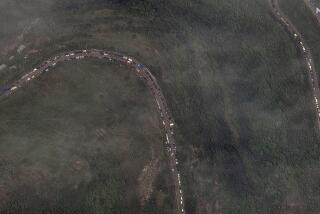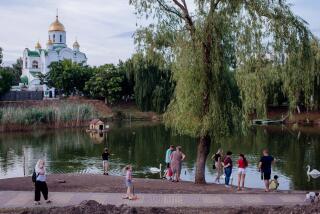The Soviet Texas: Cattle Drives, Space Station, Heavy Industry : In the Wild, Wild East, Kazakh Cowboys Still Ride the Range
- Share via
TSELINOGRAD, Soviet Union — Two cowboys, slouched in their saddles, drove a large herd of cattle along a dusty trail as twilight turned a soft summer sky to purple and gold.
It looked like a scene from the Old West in the United States, but it was contemporary reality in the Kazakh Soviet Socialist Republic, a remote part in the Soviet Union with a cowboy heritage.
The Kazakhs, a Turkic-Mongol people who trace their roots back to the 13th Century, were once nomads who roamed the range with horses and livestock.
The horse still is celebrated in Kazakh folklore and dances. In the big farmers’ market at Alma Ata, horse meat is sold for the equivalent of about $2.10 a pound and mare’s milk, known as kumiss , is also available.
Independent Frontier Spirt
The republic “is something like Texas,” said a Soviet official who has lived in the United States. “They are both places where cowboys and cattle played an important historical role and they both retain a lot of the independent frontier spirit.”
Bigger than Texas, Alaska and California combined, Kazakhstan, as it is known, also was an international crossroads in ancient times. Marco Polo traveled there along the “Great Silk Road” between China and Europe in the Middle Ages. Camels, kept in stables on state farms, are a reminder of those colorful times.
The land later became known for rich coal deposits and Stalin-era prison camps, including the gulag where novelist Alexander I. Solzhenitsyn was imprisoned.
Today, the republic is heavily industrialized--as well as coal, it produces oil and metals--and the grasslands have been fenced off by vast state grain farms. The Kazakhs, now a minority in the republic that bears their name, have abandoned their nomad life to take jobs in factories or fields.
Instead of the traditional yurta , a circular tent, the focus of attention on the Central Asian steppe is the Soviet space center at Baikonur. Watching television--there are reportedly sets in 80% of homes--has replaced daredevil horseback riding as the Kazakhs’ major recreation.
Perhaps the most fundamental change has stemmed from the periodic waves of immigration that have turned Kazakhstan into one of the most diverse Soviet republics. Of the 15 million people in the republic, only a little more than 36% are of Kazakh origin.
There are 1 million ethnic Germans, most of whom were sent to Kazakhstan during World War II from the Volga River farming areas where they and their ancestors had lived since the 18th Century. There are Koreans, expelled from Manchuria at the end of the war, and Uighurs, an Asian people who fled to the Soviet Union from China’s neighboring Xinjiang province in the late 1960s at the height of China’s Cultural Revolution. There are Uzbeks, Tadzhiks and, by official count, 100 minority groups.
And the national groups are mixing here. One marriage in five in the republic, officials said recently, unites a man and a woman of different national origins.
The most prominent group is the Russians, who represent 40% of the population; if Ukrainians and Byelorussians are included, Slavs make up 48%.
Brezhnev Square--named for the late Soviet President Leonid I. Brezhnev--dominates one part of Alma Ata, the capital of the republic, while one of its main streets is named for revolutionary leader V.I. Lenin.
Official notices and the ever-present red banners are written in Russian, the working language in Kazakhstan, though there are theaters and newspapers that use Kazakh, German, Korean and Uighuri as well.
The population exploded in the mid-1950s, when the “virgin lands” were first plowed, rising from 6 million in 1954 to more than 9 million five years later. The immigrants, mainly young Russians who volunteered to work the lands, lived in freight cars, tents and dugouts.
A Kazakh demographer, Makash B. Tatimov, has estimated that the ethnic Kazakh population alone will nearly double to 12 million during the next 25 years. He projected that the Kazakhs’ population growth rate will be 2.3% a year from now until the end of the century, then will drop sharply to 1.3% a year. This rate is almost three times as high as that of the ethnic Russian population, indicating that Kazakhs may once again be a majority in their homeland.
Tselinograd, once a dusty village, now has a population of 250,000. But the showplace of the republic is Alma Ata, a city of 1 million whose name translates roughly as “home of the apple.” It boasts many modern buildings, including a 26-story hotel that appears more elegant than anything in Moscow, with lavish use of marble and tile in its design.
There is also the unique $10.4-million Palace of Baths, which offers Oriental, Russian and Finnish baths and massage.
The Oriental bath, recalling the receiving room of a Middle Eastern potentate with its multiple arches and heated marble floors, is the favorite of the 500 customers each day. Masseurs employ their hands, feet, knees and elbows to work over their customers made limp from 122-degree heat in the final bath chamber.
Lilac-Colored Sheep
In the shadow of the Tien-Shan mountain range, Alma Ata’s streets are lined with shade trees, and its farmers’ market attracts vendors from hundreds of miles away. They bring such delicacies as raspberries, melons, grapes, apricots, figs and dates, invariably scarce or unobtainable in Moscow.
Kazakhstan also may be the only place in the world to find lilac-colored sheep, the unlikely product of scientists’ efforts to produce Karakul wool in colors other than the familiar black and gray.
It is not paradise, however. Like Southern California, Kazakhstan is prone to earthquakes and mud slides, and suffers long and dry summers. And winter brings no respite: temperatures fall as low as 40 below zero.
More to Read
Sign up for Essential California
The most important California stories and recommendations in your inbox every morning.
You may occasionally receive promotional content from the Los Angeles Times.













